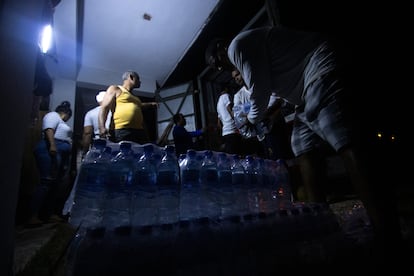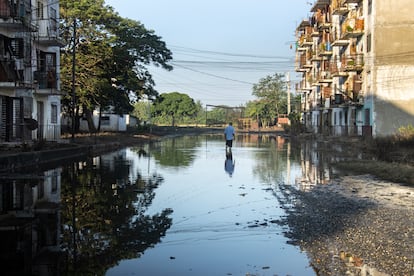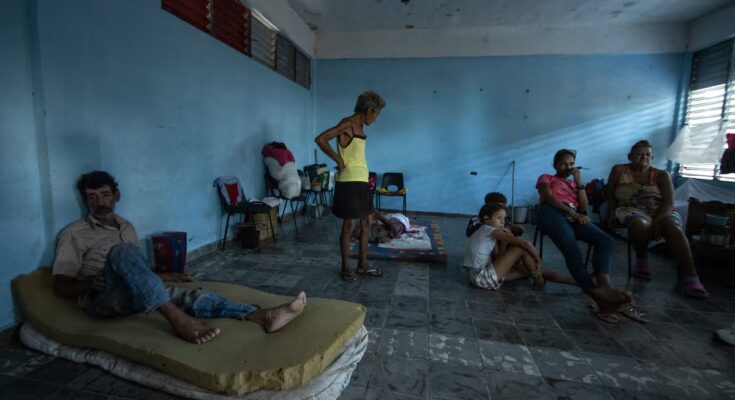It smells like death in Cauto el Paso. The stench emanating from the remains of horses, goats, cows and pigs has been swarming for two weeks in this town in the province of Granma, near the Cauto river, the largest in Cuba, which, far from living up to its name, overflowed in the early hours of October 31, after the passage of the powerful hurricane. Melissa. They appear along the road at every certain distance, mixed with the thick mud left by the floods that kept the area flooded for several days and are the living image of the impotence of the inhabitants of this territory in the eastern part of the island, so dependent on their animals, where the cyclone came to take away almost everything and to upset, even more, their already precarious lives.
Around 1 a.m. on the last day of October, when the hurricane had already left the island to continue its advance across the Caribbean, some residents of Cautious El Paso noticed that the water was reaching levels they hadn’t seen in 50 years. They warned each other, and the race against time began to protect their possessions, raising them to the top of the houses and even the roofs. Everyone expected that the hurricane would cause damage to their homes, that some roofs would be blown off, but no one warned them about the possibility of flooding. With no room for anything else, the inhabitants of the municipalities of Río Cauto and Cauto Cristo tried to save their lives and took refuge, waiting to be evacuated by the Cuban Civil Protection.
According to the United Nations mission in Cuba, Melissa It has left more than 3.5 million people affected, 90,000 homes affected or destroyed and around 100,000 hectares of crops damaged. Unlike other Caribbean islands, such as Haiti and Jamaica, where the hurricane caused the deaths of dozens of people, the Cuban authorities – who, accustomed to dealing with this type of phenomenon every hurricane season and who had evacuated almost a million inhabitants from the east of the island – did not cause any victims. But, when everything already seemed quite confused in the life of Cubans, between galloping inflation, high cost of living, spread of diseases transmitted by mosquitoes, unhealthiness and continuous blackouts, the cyclone arrived to shake everything up a little more.
15 days after the storm passed, families who lost everything are faced with rebuilding with shortages of food, fuel and medicine already on the island, bewildered as to how to get their lives back on track under these circumstances. The UN has assured that the Cuban authorities are “overwhelmed” by the devastation caused Melissa.
In Cauto el Paso, with the waters returning to their channel, families are returning to their homes, almost all standing, but flooded with thick and still wet mud, two weeks after the flood. It is possible to get there only with a tractor, one of the few vehicles capable of traveling the road to the town without getting stuck in the much mud left by the waters, which has left the community uncommunicated.
An aid that does not solve the lives of the victims
The streets are stalls selling dismantled electrical equipment and mattresses for sunbathing. “I still don’t know if all that stuff I have in the sun works and I have things inside that I no longer take out. Why so much sun? If they are needed, then they will be needed and if not we’ll see”, says Elisa Batista, 28 years old, a school librarian from Cauto el Paso, on the porch of her wooden house with a zinc roof. Batista, who lives with her young daughter, dismantled the base of her bed and placed the padding in the sun, next to the girl’s children’s books and the television. It’s been like this for five days. Like her, everyone in the community expected the typical effects of cyclonic winds and rain, so they lowered everything that was high for fear of losing their roofs. “They didn’t tell us anything about the floods, otherwise they would have brought things up,” reproaches the young woman.
The scenario that this disaster has left in cities like Cauto el Paso is critical, where pre-existing conditions of poverty are now exacerbated by the lack of basic resources. Foreign aid has begun to arrive and several countries, multilateral organizations and United Nations agencies have channeled material resources, funds and technical assistance to the areas most affected by the hurricane. Fernando Hiraldo del Castillo, resident representative of the United Nations Development Program (UNDP) in Cuba, tells EL PAÍS that his team works in the affected areas bringing supplies such as tarpaulins, metal sheets for roofs, tool kits, chainsaws and power generators “so that people can rebuild the basic conditions of their homes after the storm has passed, as well as mobilize funds for subsequent recovery actions”.

One of the initiatives that recently brought resources – food, clothing, appliances, rechargeable lamps – to the areas affected by the floods was the caravan The Cauto river in our handswith the collaboration of civil society people, foreign donors and private Cuban companies, and the approval of local authorities. The journey started from Havana to Granma, in an 18-hour journey, coordinated by Leniuska Barrero, a resident of the capital for several years, but originally from this eastern area. During the trip he repeats that this help will not solve the lives of those affected Melissabut at least it will bring some relief and solve specific problems for some people.
As the afternoon falls, the volunteers arrive at one of the houses where social workers have identified one of the most vulnerable families in the area, among the many elderly people living alone, people with physical or intellectual disabilities or single mothers with more than three children. In these cases, they take extra supplies. Yaimilín is 21 years old and pregnant with her fourth child. She and her young children receive visitors barefoot, knee-deep in mud. There isn’t much room for joy on the mother’s face when she receives the donations, even though she appears grateful. When someone asks him how he sees his future, whether he plans to one day leave Cauto el Paso and start a new life, he can only shrug and say, “I’ve always lived here.”
“A hole you have to get out of”
About 8 kilometers north of Cauto el Paso is the Grito de Yara community, which owes its name to a sugar factory, now dismantled, which was the production engine of the population living in multi-family buildings. It’s barely 7pm and darkness and mosquitoes reign in the place. For more than two weeks, when the sun sets, electric service has been an anecdote. In the midst of everything that cannot be seen, a light stands out where dozens of people gather. This is the polyclinic where a generator has been enabled to ensure the charging of electrical equipment. People come every afternoon to plug in their cell phone, lamp or portable fan. While the power station is on, residents can connect to the Internet until around midnight, when the city returns to a zone of silence.

Until, with the first rays of sun, people return to the streets of this town to try to secure what they need to face another day: from a jug of cow’s milk for breakfast, to the green bananas that a farmer passes by selling on his cart. There are those who go out with an ax to cut the first log they come across to make wood to cook with, because the bag of charcoal costs 1000 CUP (almost half the minimum wage) when it appears, and many people cannot afford it. In blackout Cuba, this has become a common way of cooking for many people.
As the afternoon passes, the parade of blue cisterns and small cisterns begins in search of water, a resource that arrives cloudy in the cisterns. There are also some cooperatives that order a truck in other areas. There are those who had to buy the water tank for 500 CUP so as not to run out of water. This is what Yunior, a 46-year-old agricultural engineer and number two of one of the agricultural cooperatives in the area, did. He lives in an apartment with his mother, wife and sister and believes he was lucky in the face of the disaster. Before Melissa died, she had time to sell her pig pen and harvest the rice she now has piled in bags inside the house. But the hurricane devastated his sweet potato crops and 30 hectares of sugar cane.
“What happened here was criminal,” says Yunior, referring to the waters that flooded the streets of Grito de Yara around dawn on October 31 and of which traces can still be seen. “This isn’t just river water in flood. It’s waste water,” warns the farmer’s mother. Before the hurricane, they warn, adequate sanitization work had not been carried out on the waste and unhealthy water tanks, at least in their building, as they had been asking the authorities for months. With the floods the waters mixed and now cover the entire street where two multi-family buildings coexist, as if it were a large pool suitable for mosquitoes, and mix with ditches of black water that run throughout the town.
Very close by is the Grito de Yara elementary school, transformed into an evacuation center, where residents of other towns still affected by the floods such as El Aguacate, Las Ova, Saladillo, El Palmar live. Its wooden houses with zinc roofs, and some brick ones, are still covered by water, so residents continue to spend the night in the center’s classrooms converted into shelters, where they sleep on mats or directly on the floor.

There awaits Nubia, 43 years old, who can’t wait to return to see what remains of her house in El Aguacate, where her husband has already passed and has seen that there is not much to save. “No one expected these waters,” says Enrique Castillo, a 57-year-old baker who owns a house with land to cultivate, just across the street from the school. Melissa It destroyed his tomato crops and 23 of his 25 beehives, but left him the hectares of rice. Enrique shows the sign of the depth reached by the water during the floods – about 1 meter high -, while lucidly reflecting on his next projects: “This area is a hole from which we have to get out. I’m fighting to leave here, because things are complicated.”
The consternation is evident in these areas afterwards Melissaand its inhabitants do not see a very promising future, which is why many consider migration. Yunior, the agronomist, thinks that within a year he will live elsewhere. “Everyone is migrating here,” he says. “In the cooperative all the staff are imported; furthermore, where the food comes from (the fields) people no longer want to work. In a year I don’t think they will recover.”



